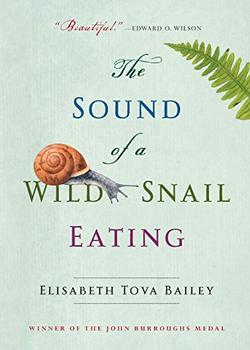Summary | Excerpt | Reviews | Beyond the Book | Read-Alikes | Genres & Themes | Author Bio

A True Story
by Elisabeth Tova BaileyThis article relates to The Sound of a Wild Snail Eating
at my feet
when did you get here?
snail
- Kobayashi Issa (1763-1828)
It's no coincidence that Elisabeth Tova Bailey chose Kobayashi Issa as one of several selected poets to gently ease us into the passages of The Sound of a Wild Snail Eating. The haiku poet's simplicity and grace complement Elisabeth Tova Bailey's quiet observations as she interprets the larger natural world through that of her tiny snail. Sometimes less is so much more, and like the mighty message of this story's small snail, haiku is a fitting medium to deepen its meaning.
Most western school-children learn that haiku is a form of Japanese poetry that uses a three-lined format of 5-7-5 syllables. This is actually wrong on a number of counts.
Firstly, Japanese haiku are not measured in syllables but in what in English are called morae or moras (from the Latin, to linger or delay), or "on" in Japanese. A fairly complex linguisitic term, moras basically measure the emphasis or weight given to a syllable so that a short syllable would be one mora, whereas a long syllable might be two or more. So, a Japanese haiku might measure 17 moras, but far fewer syllables.
A seventeen syllable haiku written in English would likely be overly verbose, and the translation of a Japanese haiku into English would usually require fewer syllables than the original. Because the essence of haiku is in its brevity, haiku poets writing in English, and those who translate haiku from Japanese, do not tend to follow the 5-7-5 rule, so as to maintain the spare integrity of the original form.
Secondly, traditional Japanese haiku are not written on three lines but in one line, usually consisting of two pairs of sensory images relating to nature separated by a pause so that the two images contrast or complement.
While the Japanese haiku that date back centuries are truly magnificent, modern poets who are able to translate their complexities without losing content are stunning in their own right. For more on the art of haiku and those whose knowledge and translations contributed to The Sound of a Wild Snail Eating, visit haikuguy.com and ahapoetry.com.
Filed under Music and the Arts
![]() This "beyond the book article" relates to The Sound of a Wild Snail Eating. It originally ran in September 2010 and has been updated for the
September 2016 paperback edition.
Go to magazine.
This "beyond the book article" relates to The Sound of a Wild Snail Eating. It originally ran in September 2010 and has been updated for the
September 2016 paperback edition.
Go to magazine.






Your guide toexceptional books
BookBrowse seeks out and recommends the best in contemporary fiction and nonfiction—books that not only engage and entertain but also deepen our understanding of ourselves and the world around us.